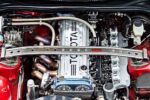Chevy 305 Engine: A Brief Overview
History and Background
The Chevy 305 engine, part of General Motors’ small-block family, made its debut in the early 1980s and quickly became a staple in various Chevrolet models, including the Camaro, Corvette, and pickup trucks. Designed as a more fuel-efficient alternative to its larger counterparts, the 305 was intended to meet the demands of a changing automotive market that increasingly prioritized fuel economy over raw power. With a displacement of 5.0 liters, the 305 engine was equipped with a two-barrel carburetor in its early iterations, which contributed to its reputation for decent fuel efficiency, especially during an era marked by rising fuel prices and stringent emissions regulations.
Despite its initial popularity, the 305 engine has garnered a mixed reputation over the years. While it was praised for its reliability and ease of maintenance, it also became notorious for a range of problems that could plague both performance and longevity. Many enthusiasts and mechanics have encountered issues that can lead to significant headaches, making it essential for owners to be aware of the potential pitfalls associated with this engine.
As the years have passed, the Chevy 305 has become a common subject of discussion among car enthusiasts and mechanics alike. Its presence in the classic car market and its role in the history of American automotive engineering make it a noteworthy topic. However, understanding the common problems associated with the 305 engine is crucial for anyone considering ownership or restoration of a vehicle equipped with this powerplant. Whether it’s a classic car enthusiast looking to restore a vintage model or a daily driver owner facing performance issues, knowledge of the Chevy 305’s shortcomings can save time, money, and frustration in the long run.
Common Problems with the Chevy 305 Engine
The Chevy 305 engine, while popular and widely used, is not without its share of issues. Understanding these problems can help owners maintain their vehicles and avoid costly repairs. Below are some of the most common problems associated with the Chevy 305 engine.
1. Oil Leaks
Oil leaks are a prevalent issue with the Chevy 305 engine. Over time, gaskets and seals can degrade, leading to leaks that can affect engine performance and longevity. Common areas where leaks occur include:
- Valve cover gaskets
- Intake manifold gaskets
- Oil pan gaskets
If left unchecked, oil leaks can lead to low oil levels, which can cause severe engine damage.
2. Overheating
Overheating is another significant concern for the Chevy 305. Several factors can contribute to this issue, including:
- Faulty thermostat
- Clogged radiator
- Water pump failure
Overheating can lead to warped cylinder heads and blown head gaskets, resulting in costly repairs.
3. Fuel System Issues
The fuel system in the Chevy 305 can also present problems. Common issues include:
- Clogged fuel injectors
- Fuel pump failure
- Dirty fuel filters
These problems can lead to poor fuel economy, rough idling, and a lack of power.
4. Ignition Problems
Ignition issues can plague the Chevy 305, affecting starting and overall engine performance. Key components to check include:
- Worn spark plugs
- Faulty ignition coils
- Damaged ignition wires
Failure to address ignition problems can lead to misfires and reduced engine efficiency.
5. Exhaust System Failures
The exhaust system can also be a source of trouble for the Chevy 305. Common issues include:
- Leaking exhaust manifolds
- Clogged catalytic converters
- Rust and corrosion in exhaust pipes
These issues can lead to increased emissions and decreased performance.
Symptoms and Consequences
Understanding the symptoms associated with these problems can help owners take action before issues escalate. Below is a table summarizing common symptoms and their potential consequences.
| Symptoms | Consequences |
|---|---|
| Oil spots under the vehicle | Engine damage due to low oil levels |
| Temperature gauge reading high | Warped cylinder heads, blown head gaskets |
| Poor fuel economy | Increased fuel costs, reduced performance |
| Engine misfires | Reduced power, potential engine damage |
| Excessive exhaust smoke | Increased emissions, potential engine failure |




0 Comments